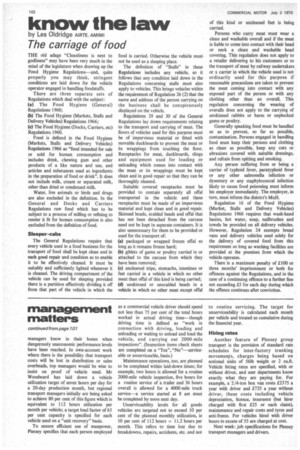know the law
Page 104

If you've noticed an error in this article please click here to report it so we can fix it.
by Les Oldridge AIRTE, AMIMI
The carriage of food
THE old adage "Cleanliness is next to godliness" may have been very much in the mind of the legislature when drawing up the Food Hygiene Regulations—and, quite properly you may think, stringent conditions are laid down for the vehicle operator engaged in handling foodstuffs.
There are three separate sets of Regulations which deal with the subject: (a) The Food Hygiene (General) Regulations 1960; (b) The Food Hygiene (Markets, Stalls and Delivery Vehicles) Regulations 1966; (c) The Food Hygiene (Docks, Carriers, etc) Regulations 1960.
Food is defined in the Food Hygiene (Markets, Stalls and Delivery Vehicles) Regulations 1966 as "food intended for sale or sold for human consumption and includes drink, chewing gum and other products of a like nature and use, and articles and substances used as ingredients in the preparation of food or drink". It does not include milk, cream or separated milk, other than dried or condensed milk.
Water, live animals or birds and drugs are also excluded in the definition. In the General and Docks and Carriers Regulations raw food which has to be subject to a process of milling or refining to render it fit for human consumption is also excluded from the definition of food.
Sleeper-cabs
The General Regulations require that every vehicle used in a food business for the transport of food shall be kept clean and in such good repair and condition as to enable it to be effectively cleaned. It must be suitably and sufficiently lighted whenever it is cleaned. The driving compartment of the vehicle can be used for sleeping provided there is a partition effectively dividing it off from that part of the vehicle in which the
food is carried. Otherwise the vehicle must, not be used as a sleeping place.
The definition of "Stalls" in these Regulations includes any vehicle, so it follows that any condition laid down in the Regulations concerning stalls must also apply to vehicles. This brings vehicles within the requirement of Regulation 26 (2) that the name and address of the person carrying on the business shall be conspicuously displayed on the vehicle.
Regulations 29 and 30 of the General Regulations lay down requirements relating to the transport and carrying of meat. The floors of vehicles used for this purpose must be of impervious material or fitted with movable duckboards to prevent the meat or its wrappings from touching the floor. Receptacles for meat, duckboards, slings and equipment used for loading or unloading which comes into contact with the meat or its wrappings must be kept clean and in good repair so that they can be thoroughly cleaned.
Suitable covered receptacles must be provided to contain separately all offal transported in the vehicle and these receptacles must be made of an impervious material and kept clean and in good repair.
Skinned heads, scalded heads and offal that has not been detached from the carcase need not be kept in separate containers. It is also unnecessary for them to be provided or used for the transport of: (a) packaged or wrapped frozen offal so long as it remains frozen hard; (b) giblets of game or poultry carried in or attached to the carcase from which they have been removed; (c) uncleaned tripe, stomachs, intestines or feet carried in a vehicle in which no other meat than offal of this kind is being carried; (d) unskinned or unscaldecl heads in a vehicle in which no other meat except offal of this kind or uncleaned feet is being carried.
Persons who carry meat must wear a clean and washable overall and if the meat is liable to come into contact with their head or neck a clean and washable head covering. This regulation does not apply to a retailer delivering to his customers or to the transport of meat by railway undertakers or a carrier in which the vehicle used is not ordinarily used for this purpose if reasonable precautions are taken to prevent the meat coming into contact with any exposed part of the person or with any clothing other than an overall. This regulation concerning the wearing of overalls does not apply to the carrying of unskinned rabbits or hares or unplucked game or poultry.
Generally speaking food must be handled so as to prevent, so far as possible, contamination. Persons engaged in handling food must keep their persons and clothing as clean as possible, keep any cuts or abrasions covered with suitable dressings, and refrain from spitting and smoking.
Any person suffering from or being a carrier of typhoid fever, paratyphoid fever or any other salmonella infection or dysentery or any staphylococcal infection likely to cause food poisoning must inform his employer immediately. The employer, in turn, must inform the district's Moll.
Regulation 16 of the Food Hygiene (Market, Stalls and Delivery Vehicles) Regulations 1966 requires that wash-hand basins, hot water, soap, nailbrushes and towels be provided on all delivery vehicles. However, Regulation 24 exempts bread vans and delivery vehicles used solely for the delivery of covered food from this requirement so long as washing facilities are provided at the premises from which the vehicle operates.
There is a maximum penalty of £100 or three months' imprisonment or both for offences against the Regulations, and in the case of a continuing offence to a further fine not exceeding £5 for each day during which the offence continues after conviction.




































































































































































